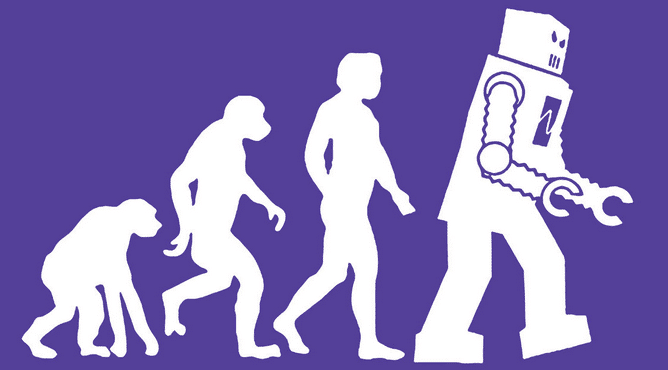
In the animal kingdom, Darwin’s explanation of evolution seems relatively straightforward. The strong survive, the fittest member finds a mate, and beneficial genes are passed along in this manner, always adjusting to the traits – sometimes swiftly (http://en.wikipedia.org/wiki/Peppered_moth_evolution), sometimes slowly (http://www.preceden.com/timelines/68990-evolution-of-the-alligator). How might this processed be modeled in robots, or to teams of robots?
Dr. Jekan Thanga is working on a productive application of this process: a bio-inspired, neuro-evolutionary process. After getting his PhD from the university of Toronto, Dr. Thanga spent his post-doc years at MIT before shifting to Arizona State, where he now heads up the school of earth and space exploration. He aims for his small robotic teams to excavate small lots to recover items, or dig out the foundation of a structure. The “bio-inspired” process of “evolving” best behaviors and interactions begins with the end in mind.
“The evolutionary process is quite simple,” Dr. Thanga begins, “what we do is we define a task, and what we have to design is a ‘fitness function’ for a task. That has to be defined quantitatively. That is, we have to have a ranking system for a task whereby 0 is absolutely bad, and 1 is brilliant.” Once the task’s completion is “grade-able,” Dr. Thanga then provides the robots with a library of potential behaviors, a library of sensory inputs that the researchers have made available, and a library of many randomly initialized scenarios that the robots can refer to.
From here… it’s survival of the fittest – but not in “real life.”
As Dr. Thanga explains, there are an infinite number of possibilities when it comes to the combinations of robot behaviors, especially with many robots interacting at once. Initial tests are run digitally, where a computer simulation helps to run the robot simulations through the task at hand, in a mere fraction of the time.
Let’s say that the task at hand involves excavating a series of metal parts from the dirt, and moving them outside of a designated boundary for pickup. A computer will randomly assign different “cohorts” of imaginary robots with different libraries of knowledge and capacities. Some robots may have the ability to use sound as a relevant sense for the task at hand, others might rely only on sight. Some robots are provided a library of behaviors that mostly involve “combing” back and forth, while others are more prone to stay put and dig in one place. Each group of robots will also have the capacity to refer to a different kind of memories of similar tasks. “What ends up happening… is that a select few of these robotic teams will make a very minor dent in the task. There will be this sort of differential between the population, where some individuals are doing slightly better than everybody else. That is part of the selection process… they mate and mutate, and live on in their children, while the unfit individuals fall off.”
Of course, Dr. Thanga’s robots do not “mate” the way we think of it – but only metaphorically. The researchers take the “winners” of the initial attempt at the task, and blend them / combine their “libraries” of senses and capacities to find slightly better performance, and this process is repeated thousands of times in a digital environment. Surprisingly, these calculations are performed – for the most part – on everyday desktop computers, “nothing super-fancy,” says Dr. Thanga. I suppose “super-fancy” is a relative term.
Once the best combinations of capacities and senses have been determined within the digital environment, the “real” robots come out to play, and the task is pursued by actual robotic teams. From here, combinations of behaviors are detected, the most relevant senses are determined, and refinement continues until the robots can perform the task sufficiently.
In the future, Dr. Thanga envisions many important applications for this “group evolution” approach to robot problem solving. “One of the big entry points of this technology is that all it requires is a group of imperfect individuals to come up with a robust system. In the other paradigm, you need to have a single paradigm that is nearly perfect.” He explains that a group of robots – even with seemingly major limitations – can come together and reliably accomplish a task. This might occur even if one of the robots breaks down, or if no individual robot is capable of the entire task.
One important use of such a robot team is in the automation of large-scale excavation work – and Dr. Thanga believes that this applies to alternative energy. In the setup of large-scale solar and thermal energy plants (http://www.abc.net.au/radionational/programs/scienceshow/s/4639974), for example, hundreds or thousands of mirrors must be adjusted to point towards a central unit in order to convert heat to electricity. “The market understands that in order for [alternative energy] to take off, it must be cheaper.” The down-side to these large-scale alternative energy plants is that they require setup and continued maintenance, often in deserts or other difficult environments. If robots could set up and maintain these panels and systems efficiently, it would reduce human risk, and human risk. A situation of this sort might just be an initial test-bed for the application of “neuro-evololved” robot teams.
Image: mind42.com







